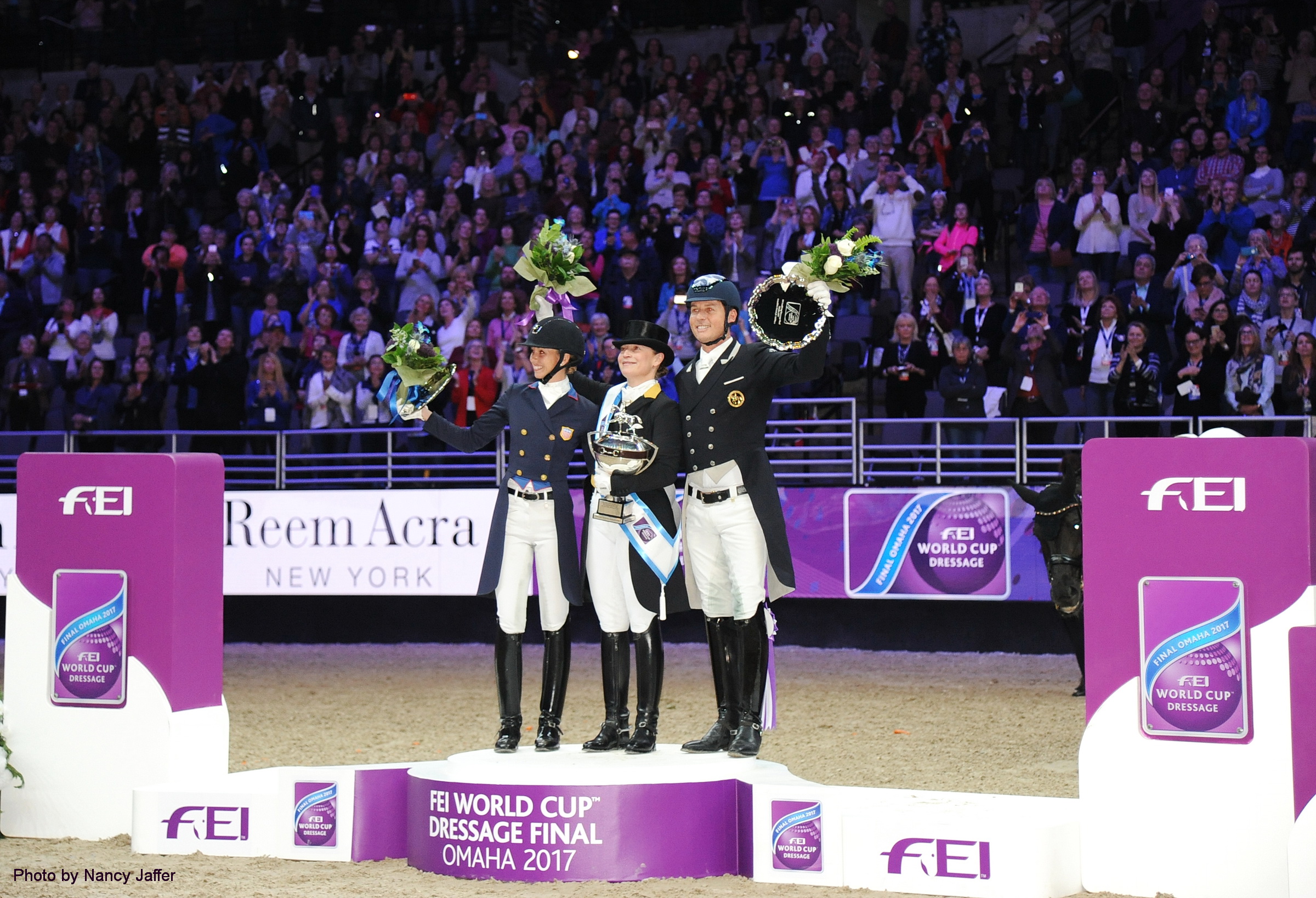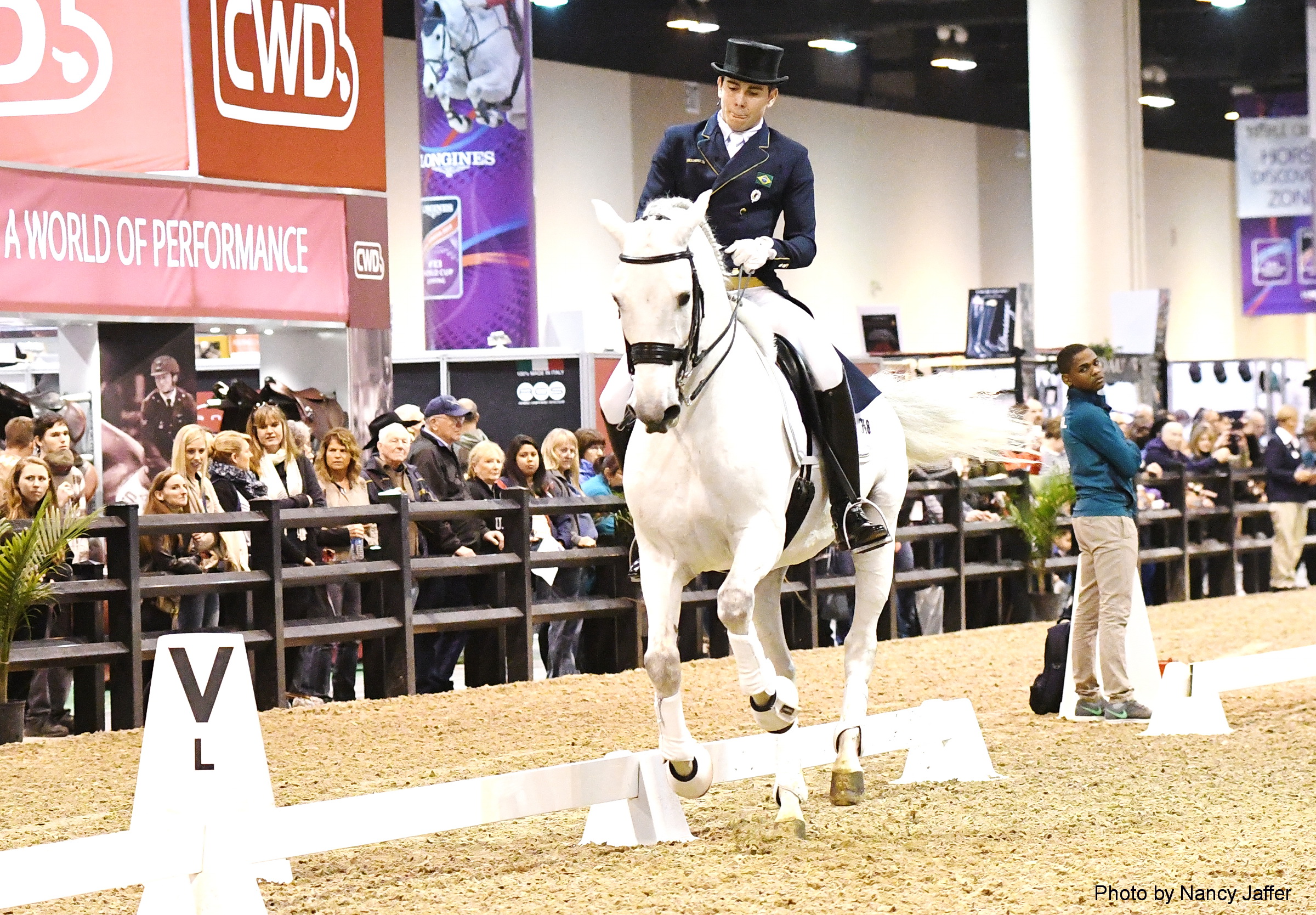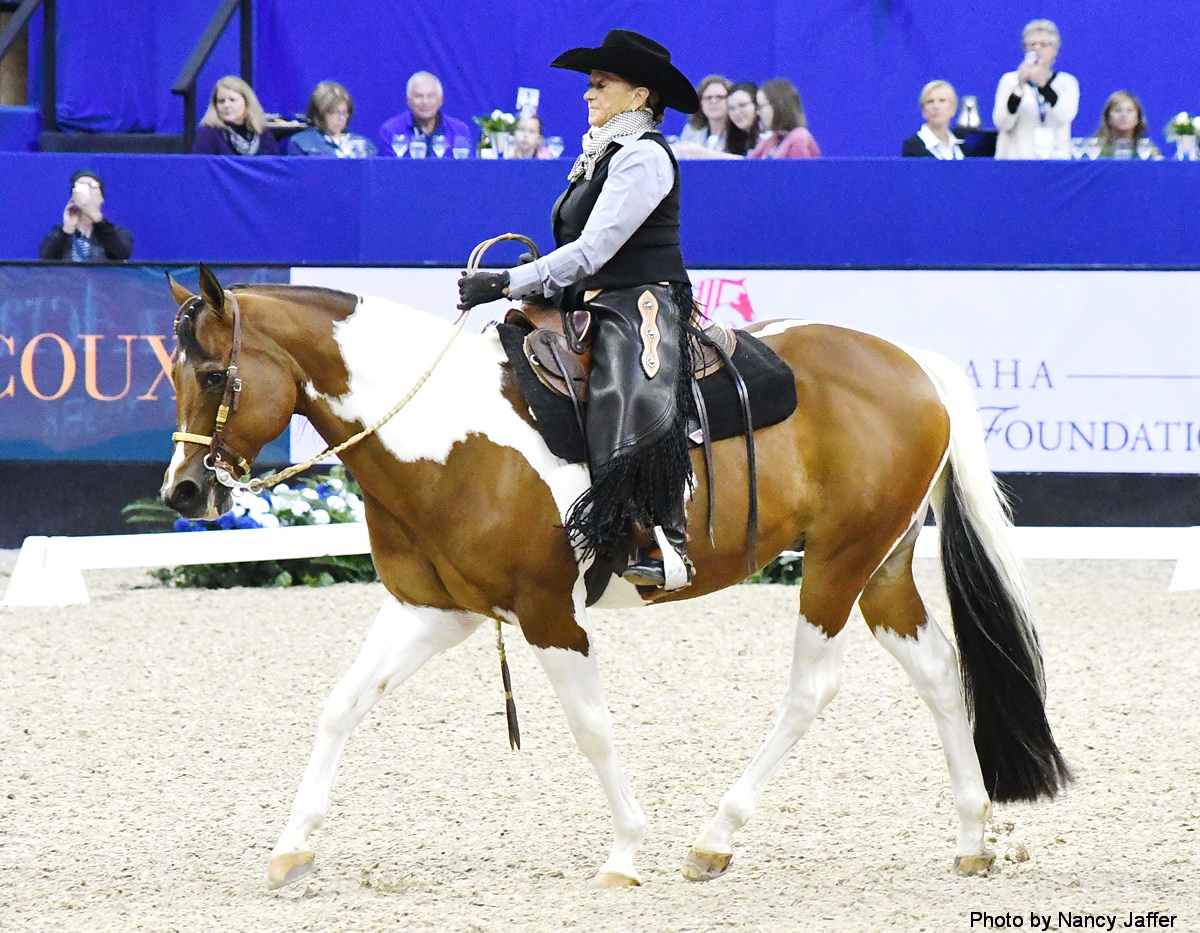
(Nancy Jaffer)
The applause ended, the white fences were moved out of the CenturyLink Center and the Grand Prix horses flew home. But the impact of the 2017 FEI World Cup™ Dressage Final in Omaha, Nebraska, will continue to be felt throughout the Midwest because of a strategic plan designed to expand the discipline in a region where it doesn’t have the popularity it enjoys on the East and West Coasts.
After visiting the World Cup Finals in Las Vegas eight years ago, Lisa Roskens, an amateur jumper rider who is chairman of the Omaha Equestrian Foundation and CEO of Burlington Capital, decided to bid for the event. She realized that CenturyLink, in the heart of Omaha, would be a great place to stage the competition, which also included the Longines FEI World Cup Jumping Final. And it absolutely was the right venue.
The competition and everything associated with it received copious praise from the FEI as well as from riders, grooms, officials, vendors and visitors.
“The standout fact for me,” said USEF Director of Sport Will Connell, “was the attitude of everybody—we want to make this a fantastic success and enjoyable. Whenever you asked for anything, it was done if they could. This is how to run a friendly, successful and professional event. They made it an event rather than a series of competitions.”
Although the accolades were welcome, at the heart of Roskens’ concept was a broader vision that went far beyond simply presenting successful finals. “We asked to host the World Cup Finals for a very specific reason, which is growing the sports in the region. We hosted it with a purpose,” noted Roskens.
A detailed five-year strategic plan for jumping at the annual International Omaha show was revealed during the World Cup. Its centerpiece involves bringing in other shows throughout the region for the nationally televised In It to Win It Speed Jumping series, with a final each year at the International.
Compared to that outline, dressage is still more of a work in progress, but it’s coming along. Amateur dressage enthusiast Robin Wright noted, “You can still feel the energy from the World Cup. The education lit so many fires that it blazed a new trail. The Midwest has been a dressage desert, as my friends and I like to call it. We are thrilled to have the new life Lisa’s initiatives will bring into the area.”
The region’s entire dressage community is excited at the prospect, and one of the goals of the World Cup was to broaden the base and bring out more people “to help us grow the sport that we all love,” as Roskens put it.
“It’s gratifying the World Cup created an interest in helping [dressage in the Midwest] get better,” Roskens pointed out. “And The Dressage Foundation has been amazing. They’re the ones that underwrote the Showcase with Isabell [Werth] and they’ve given us some good guidance.”
Nebraska-based freelance dressage trainer Shan Lawton agrees that Roskens has been a tremendous advocate of the sport. “Lisa is not a dressage rider, but she’s maybe one of the Midwest dressage community’s biggest assets,” he said. “She’s just tireless and has a wonderful ability to organize and promote things. One of the characteristics of the Midwest is that people here are somewhat cautious. On either coast, things happen really quickly and they come and they go. In the Midwest, we just kind of keep going. Right now, we don’t have a dressage center that’s like Wellington or even the Pacific Northwest, where there’s a lot of dressage.”
Despite that, Lawton asserted, “it’s an excellent location,” an assessment verified by trainer Missy Fladland, who performed in a pas de deux exhibition during the Dressage Showcase at the World Cup Finals.
Fladland, who gives Roskens dressage lessons to round out the executive’s riding skills, noted the cup brought some enlightenment to those in the Midwest who maybe weren’t aware of dressage. “But it also probably inspired quite a few young and up-and-coming riders of what they could attain if they work hard and get into a program and have desire and commitment,” Fladland said.
In her view, “The International already has made an impact and caused people to better themselves. Any time you put yourself into a situation where there are better riders than what you are currently, it makes you ride better. The only way at this point in the Midwest that we are going to continue to grow is to add to our existing competitions. With an international competition available, the local trainers and kids who are ready for an international-type competition will have that available to them if they don’t have the chance to go to Florida. It really broadens people’s understanding and spectrum of what the ability of a Grand Prix horse can be.”
As Fladland noted, “It’s one thing to see it on a video. It’s a whole other thing to see it in person. It’s hard to describe, but once you see it, you’re like ‘Oh!’ It really helps people learn.”
She likes the idea of having a young rider get a connection in the pipeline somewhere and get started. “I think a lot of kids would be interested in doing that,” she said.

International Omaha 2018
As was the case with the test event for the World Cup at the 2016 International Omaha show, lots of prize money and the promise of a good competitive experience are expected to draw competitors to the dressage segment of the 2018 show. This time, however, it won’t be the dressage Grand Prix that is highlighted. Instead, organizers are being realistic, planning on holding a Small Tour CDI (international) competition with significant prize money at the annual April show, which will be staged after the Adequan Global Dressage Festival in Florida ends.
The Small Tour freestyle will get a prime time berth as the feature ticketed event on one of the evenings of the show, that traditionally has been devoted to show jumping.
Interestingly, as was the case at the Las Vegas World Cup in 2015, Saturday’s Grand Prix freestyle outsold the Sunday show jumping finale in Omaha.
The 2018 show will, to a certain extent, pick up where the World Cup left off, though, of course, it won’t be the same and will be missing the global stars such as Germany’s Isabell Werth, who won the 2017 World Cup, or the USA’s Laura Graves, who was second.
Discussing the agenda for the International Omaha 2018, Roskens noted, “It might not be the World Cup, but it still will be a fun weekend in Omaha.”
Plans call for CenturyLink to be configured in much the same way as it was for the finals, with the warm-up arena surrounded by vendors and places to eat. An educational expo will be part of the footprint as well. A Junior and Young Rider dressage competition is slated as an addition to the International and organizers are working on a “local day” for dressage to reach the grassroots that can help grow the discipline. At the same time, an educational feature—similar to the Dressage Showcase held during the World Cup—also is being formulated.
There will be an opportunity for lucky up-and-coming riders to shadow CDI riders or take lessons from them, maximizing the local impact of having big names on the entry list at CenturyLink.
“We’re fundamentally tripling what we’re doing for dressage at the International,” said Roskens. “We need to figure out what’s going to work in our region.”
A History of Dressage in Nebraska
Ironically, it was in nearby Lincoln, Nebraska, that the U.S. Dressage Federation (USDF) was born in 1973 and headquartered for many years under the stewardship of founder Lowell Boomer. The USDF remained in Lincoln, where championship competitions were held during the early years of the federation, until a move to Kentucky in 2002. The USDF is now based in its own headquarters at the Kentucky Horse Park in Lexington.
The Dressage Foundation, however, is still located in Lincoln. So dressage has real roots in the area. Now the Omaha Equestrian Foundation is seeking to grow them and have the sport bloom in the Midwest.
“We have had a pretty solid group of people for quite a long time,” said Fladland, who believes the core of that stems from the USDF’s founding and Boomer’s influence, even though the big growth of the discipline has been on the coasts. She said it will be interesting to see as time goes on how having had the World Cup in Omaha does impact the sport in the Midwest.
“I’m hoping some of the people who came through [CenturyLink] who weren’t aware of what dressage was are very interested and are seeking out professionals in the area to have lessons and find out about programs and different things for their kids.”
Fladland sees real progress in her region and the promise of more to come. “It already is starting to build. Having top-quality shows from Chicago [Lamplight Equestrian Center with its Children’s, Pony, Junior and Young Rider National Championships, as well as the Markel/USEF Young and Developing Horse National Championships and USEF Dressage Seat Medal Finals] to Omaha to Colorado [the Colorado Horse Park, which held its first CDI in May and had scheduled Steffen Peters and Lars Petersen there to teach] makes this area even that more appealing to top-quality riders, and that encourages people in our area to better themselves. It could be a nice group of CDIs coming off of Florida,” she said.
“We’re incredibly fortunate to have such an amazing opportunity with a show like the International for people like myself, who are what I would call ‘locals.’ I feel really blessed that Lisa is putting this on and feel really excited about being part of it to grow the dressage and jumpers, too, to make that show as big a success as we can.”
Wright, who works as a health inspector, noted that many people without equestrian expertise or interest attended the World Cup, just as they did the Olympic swim team trials when they were at CenturyLink. “It’s in Omaha, so we’re going,” is the mindset, demonstrating the advantage of having a major equestrian competition in a small city where the featured sporting event is the only game in town, as opposed to in busy, bustling cities such as Paris, the World Cup’s venue for 2018, or Las Vegas, which will host the finals again in 2020 for the seventh time.

Growing the Sport
The fact that so many non-equestrians went to the finals because they were an Omaha attraction turned out to be a good thing for equestrians in a way one might not expect. In Wright’s case, attendance at the finals brought new understanding from co-workers who previously gave her a blank stare when she mentioned dressage or asked, “I didn’t know you were into soccer” after she talked about attending the World Cup.
Connell notes there is precedent for growth of a discipline in a region after a successful championship.
“If you look in other parts of the world, and especially what happened in Britain after the London 2012 Olympics [where the British claimed the team and individual gold medals], the explosion of interest in dressage was very obvious,” said Connell.
He cited an increase in competitions, the number of starters and the British Dressage organization’s membership post-2012 and, of course, the charisma of Charlotte Dujardin and Valegro.
Another element is the fact that dressage lends itself to growth once people discover it.
“Dressage is a very easy discipline for people to participate in and enjoy right through later years of life,” Connell pointed out. “It doesn’t require huge facilities, such as cross-country courses. It’s not labor-intensive in terms of running [a show] or competing in dressage. If people get the bug for doing it, there is no reason why it shouldn’t grow [in the area].”
There is another plus that is helpful in these busy times, when people have so many demands on their days, evenings and weekends. “The safety side of dressage is such that you can pick it up and put it down,” he said. “It’s a sport you can enjoy at the lower levels without having to train for hours every day. People should give it a try.”
He also pointed out that there is a large Western riding population in the Midwest and Western dressage is a discipline that is growing enormously. There was even a Western dressage demonstration during the finals.
“So if it’s not classical dressage, then maybe it will be a combination of the two,” Connell commented while discussing the possibilities for growth in the region.
As he mentioned, for those used to riding Western, “it seems to be a perfectly good way into the sport.” But as time goes on and riders gain in expertise, “If you want to do the more advanced movements, then clearly the classic dressage route is the way forward.”

In Connell’s view, a big part of the finals’ impact came through what really amounted to civic pride. He noted the way organizers and volunteers embraced the event. “It was clear everyone wanted it to be a success,” he said, believing that the accessibility of the demonstration arena and warm-up area will have shown a lot of people other avenues for horse sport beyond the upper levels while giving them an understanding of what the sport entails beyond the spotlight.
Connell came up with the idea of having a host city for this fall’s first full-scale USEF high-performance competition review, and Roskens suggested Omaha could fill that bill. The review will feature discussions among veterinarians, chefs d’equipe, coaches, team leaders, physiotherapists, farriers and others involved in the country’s competitive equestrian efforts less than a year before the 2018 FEI World Equestrian Games are scheduled to take place in Tryon, North Carolina. “I don’t think we’ve had a review in this country where all eight disciplines have come together to really look at how we improve performance,” said Connell, who expects more than 50 people to attend.
The presence of that event underlines the fact that Omaha is continuing to be a big player on the equestrian scene. While some saw the World Cup Finals as an end unto itself, it turns out that actually was just the beginning.
This article first appeared in the July 2017 issue of Dressage Today magazine.











